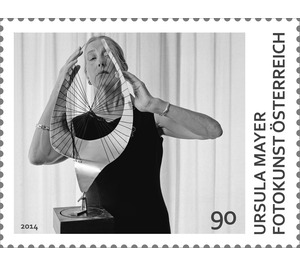photography - Austria / II. Republic of Austria 2014 - 90 Euro Cent
Theme: Art & Culture
| Country | Austria / II. Republic of Austria |
| Issue Date | 2014 |
| Face Value | 90.00 |
| Edition Issued | 230,000 |
| Printing Type | offset |
| Stamp Type | Commemorative |
| Item Type | Stamp |
| Chronological Issue Number | 2504 |
| Chronological Chapter | OOS-OE2 |
| SID | 155812 |
| In 64 Wishlists | |
The continuation of the popular stamp series "Photographic Art Austria" once again honors a contemporary media artist: Ursula Mayer - internationally sought-after artists, whose overall installations of videos, photographs, sculptures and performances create a creative density that captivates and challenges the viewer. Ursula Mayer was born in 1970 in Upper Austria and attended the Academy of Fine Arts in Vienna. Already during this time, she moved to London, where she studied at the Royal College of Art and later completed a master's degree at Goldsmiths College. In 1996, Ursula Mayer began exhibiting worldwide, her work has been presented in such cities as London, New York, Rome, Paris, Helsinki, Moscow, Berlin or Vienna. In addition to several other awards, she was awarded the Msgr. Otto Mauer Prize in 2007, and in 2011 she received a scholarship from the International Studio & Curatorial Program (ISCP) in New York. Mayer's films and videos deserve special recognition. An important element of her work are repetitions of dream-like scenes and sequences, which allow slight variations by constantly new interpretations and thus involve the audience and encourage him in his role. These surrealistic repetitions also break up the classic narrative thread of a film; strong images, artificially arranged scenes and seemingly missing action intensify the effect of their works. Another significant feature of Ursula Mayer's filmmaking is the relationship of the characters to the architectural spaces in which they move. In 2006, the three-minute film "Interiors" was created, which particularly highlights this connection. The filming location was the home of architect Erno Goldfinger in London's Hampstead, which served as a meeting place for artists and intellectuals, especially in the 1930s, and today houses a significant collection of modern art. "Interiors" shows the repetitive gestures and interactions of two similar women of different ages who are in this house but never meet. The lack of dialogues and the sparing use of background sound amplify the special atmosphere of the film. The brand motif shows a section of "Interiors", the superficial sculpture by the British sculptor Barbara Hepworth forms a central point in the film - it is symbolic of the silent communication between two generations of women and determined by their hypnotic rotation of the rhythm and movements of the short film.


